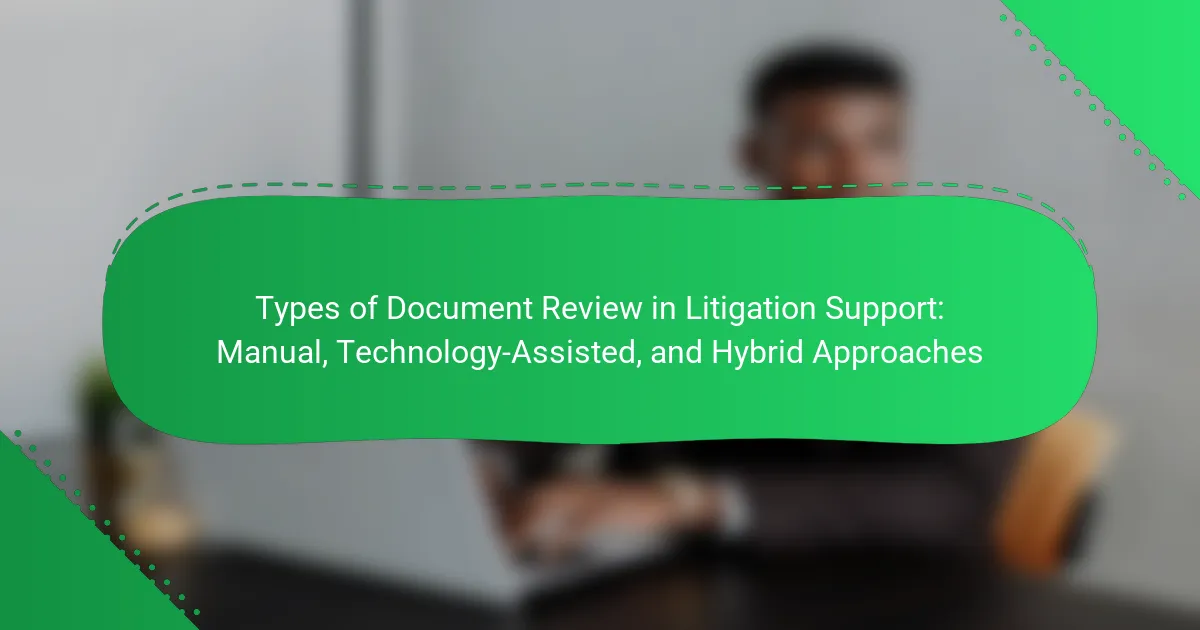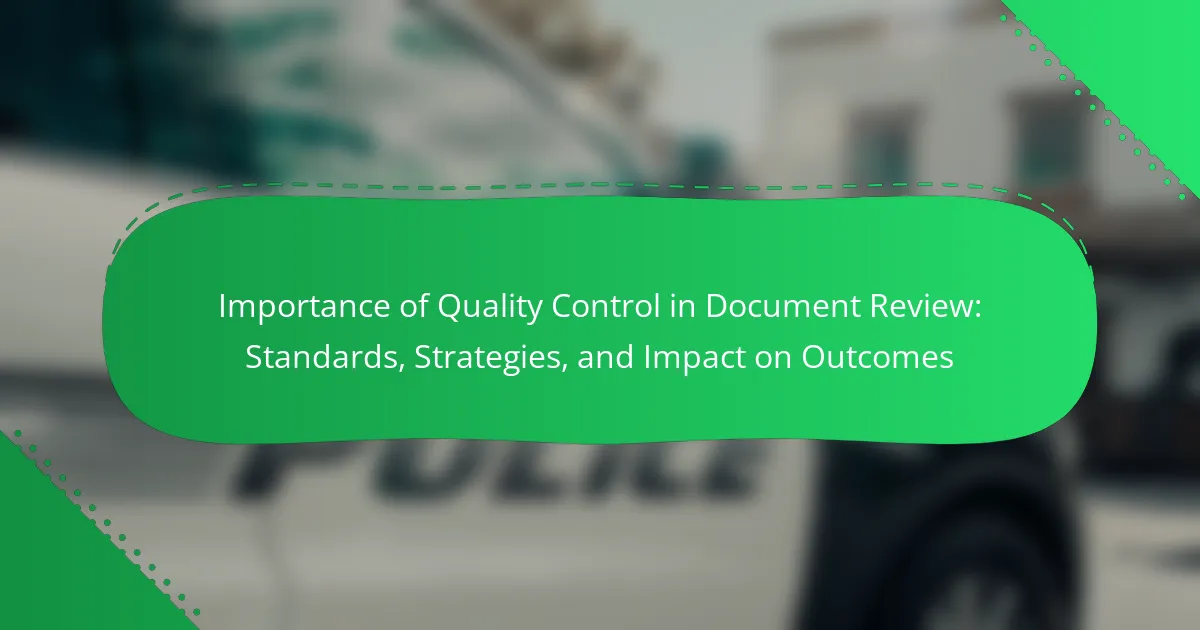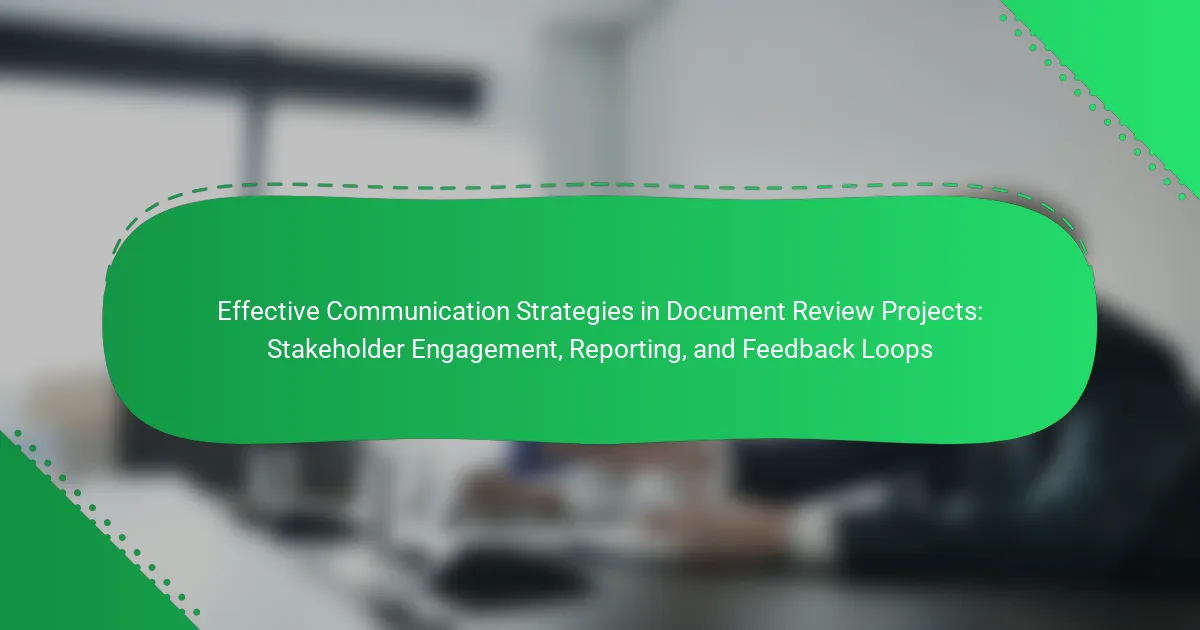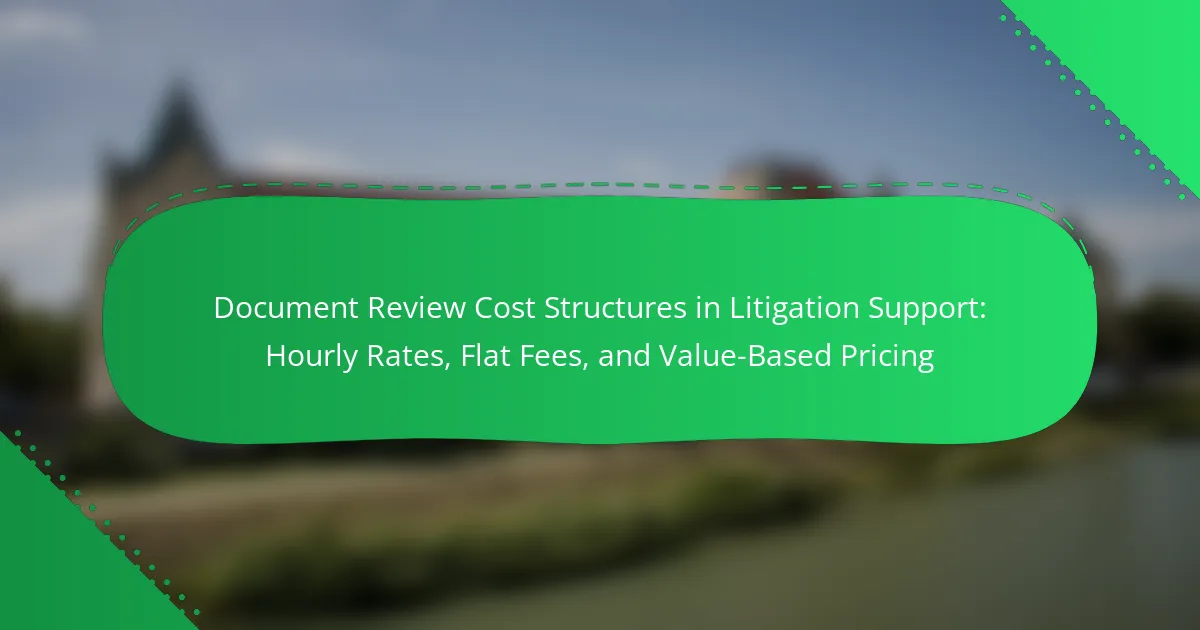Document review in litigation support involves three primary types: manual review, technology-assisted review (TAR), and hybrid review. Manual review relies on human reviewers to assess documents for relevance and privilege, ensuring thoroughness but often requiring significant time and labor. Technology-assisted review employs software to analyze and categorize documents, enhancing efficiency and accuracy through algorithmic prioritization. Hybrid review merges the benefits of both manual and technology-assisted methods, utilizing technology for preliminary sorting while reserving human expertise for final evaluations. Each approach offers distinct advantages tailored to the specific demands of litigation cases.
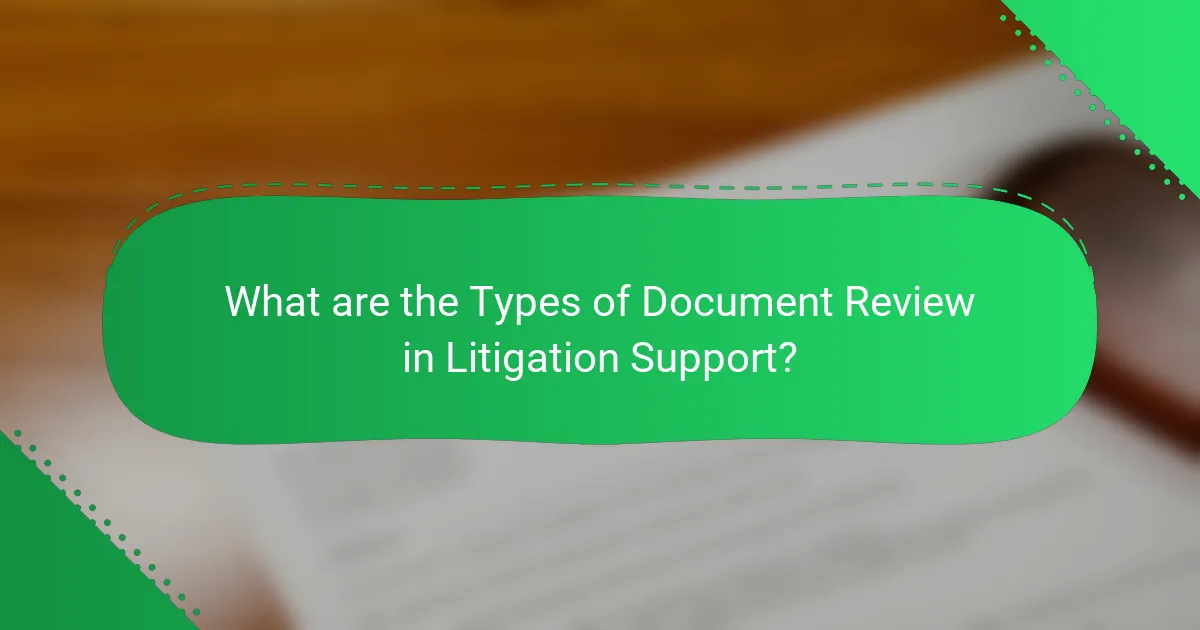
What are the Types of Document Review in Litigation Support?
The types of document review in litigation support include manual review, technology-assisted review, and hybrid review. Manual review involves human reviewers examining documents for relevance and privilege. This traditional method ensures thoroughness but can be time-consuming and labor-intensive. Technology-assisted review (TAR) uses software to analyze and categorize documents. TAR leverages algorithms to prioritize documents, improving efficiency and accuracy. Hybrid review combines both manual and technology-assisted approaches. This method optimizes resources by using technology for initial sorting and human reviewers for final assessments. Each type has its advantages and is chosen based on the specific needs of the litigation case.
How do Manual Approaches work in Document Review?
Manual approaches in document review involve human reviewers analyzing documents without automated tools. Reviewers read each document to identify relevant information. They assess documents based on specific criteria set by the legal team. This process requires significant time and attention to detail. Manual reviews often yield high accuracy due to human judgment. Reviewers can understand context and nuances better than machines. They categorize documents as relevant, irrelevant, or privileged. The manual approach is traditionally used in complex cases with sensitive information.
What are the key characteristics of Manual Document Review?
Manual Document Review is a meticulous process involving human evaluators examining documents for relevance and accuracy. This approach relies heavily on the expertise of reviewers to interpret content contextually. Reviewers assess each document individually, ensuring thoroughness and attention to detail. The process often includes identifying key information, categorizing documents, and flagging issues for further consideration. Manual review can adapt to complex legal language and nuances that automated systems may overlook. It is time-consuming but allows for higher accuracy in sensitive cases. According to a study by the American Bar Association, manual reviews can yield a 95% accuracy rate when conducted by experienced professionals.
What are the advantages and disadvantages of Manual Document Review?
Manual document review offers several advantages and disadvantages.
Advantages include thoroughness and accuracy. Human reviewers can understand context and nuances that automated systems may miss. They can identify relevant documents based on subjective criteria, which is crucial in legal contexts. Additionally, manual reviews can adapt to changing requirements during the review process.
Disadvantages involve time consumption and higher costs. Manual reviews typically take longer than automated methods, especially for large volumes of documents. This can lead to increased labor costs. Human error is also a risk, as fatigue can impact the quality of the review.
In summary, while manual document review is precise and context-aware, it is often slower and more expensive compared to technology-assisted methods.
What is Technology-Assisted Document Review?
Technology-Assisted Document Review (TADR) is a process that uses software to aid in the examination and analysis of documents. This method enhances efficiency and accuracy in identifying relevant information during legal proceedings. TADR employs algorithms and machine learning to categorize and prioritize documents based on their relevance to specific legal issues. Studies show that TADR can significantly reduce the time and cost associated with traditional manual document review. For instance, a 2016 study by the RAND Corporation found that TADR can lower review costs by up to 50%. This approach is increasingly adopted in litigation support due to its ability to handle large volumes of data effectively.
How does Technology-Assisted Document Review function?
Technology-Assisted Document Review (TADR) functions by utilizing software to analyze and categorize large volumes of documents. This process typically involves machine learning algorithms that identify relevant information based on predefined criteria. TADR begins with the ingestion of documents into a review platform. The software then applies algorithms to detect patterns and classify documents. Reviewers can prioritize documents based on relevance scores generated by the technology. This method significantly reduces the time and effort required for manual review. Studies show that TADR can improve accuracy and efficiency in identifying pertinent documents. For example, a 2012 study by the RAND Corporation indicated that TADR can reduce review costs by up to 50%.
What technologies are commonly used in Technology-Assisted Document Review?
Technologies commonly used in Technology-Assisted Document Review include machine learning algorithms, natural language processing, and predictive coding. Machine learning algorithms analyze large datasets to identify relevant documents. Natural language processing helps in understanding and categorizing text within documents. Predictive coding automates the review process by predicting which documents are likely relevant based on prior coding decisions. These technologies enhance efficiency and accuracy in document review. Studies show that these tools can significantly reduce the time and cost associated with traditional document review methods.
What defines Hybrid Approaches in Document Review?
Hybrid approaches in document review combine manual and technology-assisted methods. This strategy leverages both human judgment and automated tools. It aims to enhance efficiency and accuracy in the review process. Human reviewers analyze complex documents while technology handles repetitive tasks. This dual approach can reduce review time significantly. Studies show that hybrid methods can improve accuracy rates compared to manual-only reviews. By integrating technology, firms can manage larger volumes of documents effectively. Hybrid approaches are particularly beneficial in litigation support, where precision is crucial.
How do Hybrid Approaches combine Manual and Technology-Assisted methods?
Hybrid approaches combine manual and technology-assisted methods by integrating human expertise with automated tools. This integration allows for enhanced efficiency and accuracy in document review. Manual methods involve human reviewers assessing documents for relevance and privilege. Technology-assisted methods utilize software to identify, categorize, and prioritize documents based on specific criteria. Hybrid approaches leverage the strengths of both methods. For instance, technology can quickly process large volumes of data, while human reviewers can apply contextual judgment to complex cases. Studies show that hybrid methods can significantly reduce review times while maintaining high accuracy rates. This combination results in a more effective litigation support process.
What are the benefits of using Hybrid Approaches in Document Review?
Hybrid approaches in document review combine manual and technology-assisted methods. This combination enhances efficiency and accuracy in the review process. Hybrid methods leverage technology to filter and prioritize documents. They reduce the volume of materials that require human review. This results in significant time savings for legal teams. Furthermore, hybrid approaches improve the consistency of document analysis. They allow for better collaboration among team members. Studies show that hybrid methods can increase the speed of review by up to 50%. Overall, hybrid approaches optimize resources while maintaining high-quality outcomes in document review.
What factors influence the choice of Document Review type?
The choice of Document Review type is influenced by several key factors. These factors include the volume of documents, the complexity of the case, and the budget available for the review process. High document volumes often necessitate technology-assisted reviews for efficiency. Complex cases may require more detailed manual review to ensure accuracy. Budget constraints can limit options, making cost-effective solutions essential. Additionally, the timeline for the review can impact the choice, with tighter deadlines favoring technology-assisted methods. The expertise of the review team also plays a role, as skilled reviewers can effectively handle manual reviews. Lastly, the specific legal requirements of the case can dictate the appropriate review type.
How can one determine the best Document Review approach for a case?
To determine the best Document Review approach for a case, assess the case’s complexity and volume of documents. Manual review suits smaller cases with fewer documents. Technology-assisted review is effective for larger datasets, leveraging algorithms for efficiency. Hybrid approaches combine both methods for flexibility and thoroughness. Consider the budget and timeline as well. Studies show technology-assisted review can reduce costs by up to 40% compared to manual review. Evaluate the specific needs of the case to select the most suitable approach.
What considerations should be made regarding case complexity and volume?
Case complexity and volume significantly influence the document review process. Complex cases often involve intricate legal issues, multiple parties, and extensive evidence. High volume cases may require efficient management strategies to handle large quantities of documents. The choice between manual, technology-assisted, or hybrid approaches depends on these factors. For instance, technology-assisted reviews can expedite processes in high-volume scenarios. Conversely, manual reviews may be necessary for nuanced cases requiring detailed analysis. Understanding these dynamics is crucial for optimizing resource allocation and ensuring thoroughness in reviews.
How do budget constraints affect the choice of Document Review type?
Budget constraints significantly influence the choice of Document Review type. Organizations with limited budgets often opt for manual document reviews due to lower upfront costs. Manual reviews require more time and labor, which can increase overall expenses if the volume of documents is high. Conversely, technology-assisted reviews, while initially more expensive, can reduce costs in large-scale projects by speeding up the process and improving accuracy. Hybrid approaches can balance cost and efficiency, providing a middle ground. The selection ultimately depends on the volume of documents, complexity of the case, and available resources. A study by the American Bar Association found that firms utilizing technology-assisted reviews reported a 30% reduction in costs compared to manual methods.
What best practices should be followed in Document Review?
Best practices in document review include establishing clear objectives and guidelines. Clear objectives ensure that reviewers understand the scope and purpose of the review. Guidelines help maintain consistency across the review process.
Utilizing technology can enhance efficiency and accuracy. Technology-assisted review tools can help identify relevant documents quickly. Manual reviews should still be thorough to catch nuances that technology may miss.
Regular training for reviewers is essential. Training keeps team members updated on best practices and software tools. Collaboration among team members can improve the quality of the review.
Implementing a quality control process is crucial. Quality control checks help identify errors and ensure compliance with legal standards. Documenting the review process provides transparency and accountability.
Finally, maintaining open communication with stakeholders is important. Regular updates keep all parties informed about progress and findings. These practices collectively improve the effectiveness of the document review process.
The main entity of this article is document review in litigation support, which encompasses three primary types: manual review, technology-assisted review, and hybrid review. Manual review relies on human evaluators to assess documents for relevance and privilege, ensuring high accuracy but often resulting in longer review times. Technology-assisted review employs software algorithms to efficiently categorize and prioritize documents, significantly reducing costs and time. Hybrid approaches combine both methods, leveraging technology for initial sorting while utilizing human judgment for final assessments, optimizing resources and enhancing overall accuracy. The article further explores the characteristics, advantages, disadvantages, and best practices associated with each review type, providing a comprehensive overview for legal professionals.
